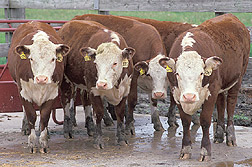Keeping Cattle Cool Makes Sense |
|
|
|
During hot summer days, Americans go swimming, drink lemonade, or move inside to air conditioning to cool down. But cattle stay outside, with nothing to cool them. This reduces their growth and efficiency, ARS scientists say. While nobody is suggesting placing cattle on beach blankets, with sunglasses and strawberry daiquiris to sip, researchers at the Roman L. Hruska U.S. Meat Animal Research Center in Clay Center, Nebraska, have new information to help producers recognize when their cattle are stressed by heat and humidity, which should aid in planning for relief when a heat wave occurs. A heat wave is 3 or more consecutive days of extremely hot conditions. Hot summers have always affected farmers in certain areas of the country. Heat waves, though, occurred more often in the 1990s than in the previous four decades. Some also lasted longer and were more intense than those of the past, according to recently retired agricultural engineer and biometeorologist G. LeRoy Hahn. Heat waves are usually most severe from mid-June to mid-August, when many cattle are near market weight. In the heat wave of 1997 farmers lost $28 million and in the one of 1999, $40 million, because of cattle deaths and decreased performance. During heat waves, beef cattle do not grow as fast or as efficiently, and dairy cattle don't produce as much milk. Production goes down even more when temperatures remain too warm at night for the animal to recover from the day's heat. There are a few ways to observe whether cattle might be heat-stressed. A simple way is to compare the temperature and humidity to a graph to see whether the animal is in the danger area. But Hahn thinks that "the animal is the best sensor," and respiration rate is a way to measure heat stress. When humans get hot, they sweat. Cattle, on the other hand, do little sweating. They lose heat mainly through respiration and, eventually, panting. During hot days, Hahn says, farmers should count the breaths per minute of a few cattle to see if they exceed the healthy rate of 60 to 80. This can be done with a simple stopwatch, but colleague Roger Eigenberg, an agricultural engineer, has developed a respiration monitor that can be attached securely to the cow to record its breathing rate. This device is currently available only as a research tool. There are two general ways to help the animal when it's heat-stressed. One way is with a sprinkler system. Agricultural engineer John Nienaber notes that watering should not be done constantly; the animal needs some time to dry before you wet it again because evaporation is what keeps it cool. Also, continued watering creates muddy conditions. Another way is to provide shade or shelter for the animal, but this can be expensive. Hahn thinks the cost of keeping the animal cool is a form of insurance against death losses in extreme heat waves and that it can save money down the road by improving production even during less-stressing conditions.—By David Elstein, Agricultural Research Service Information Staff. This research is part of Animal Well-Being and Stress Control Systems, an ARS National Program (#105) described on the World Wide Web at http://www.nps.ars.usda.gov. LeRoy Hahn, Roger Eigenberg, and John Nienaber are with the USDA-ARS Roman L. Hruska U.S. Meat Animal Research Center, P.O. Box 166, Clay Center, NE 68933-0166; phone (402) 762-4100, fax (402) 762-4273. |
|
"Keeping Cattle Cool Makes Sense" was published in the July 2002 issue of Agricultural Research magazine. |







